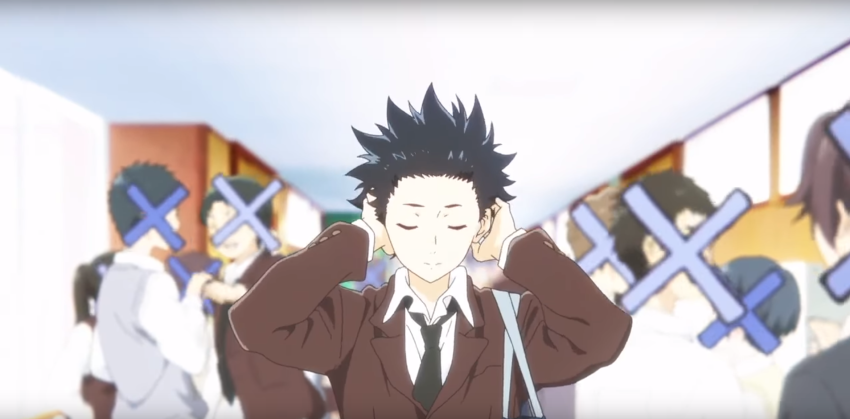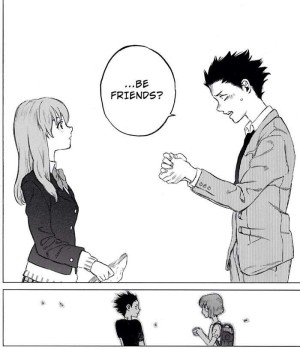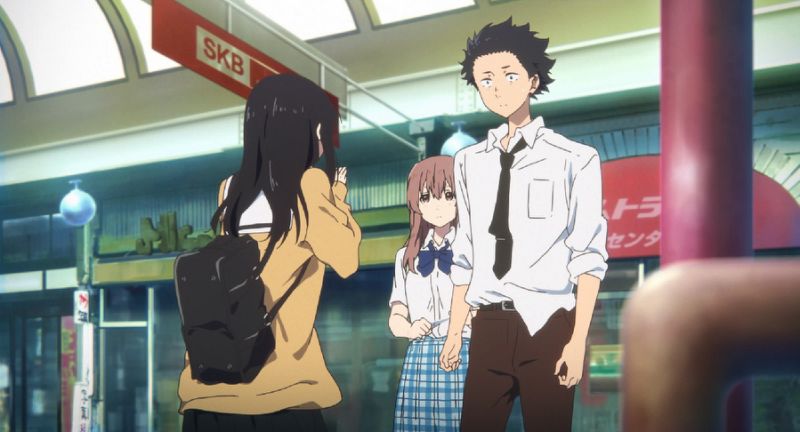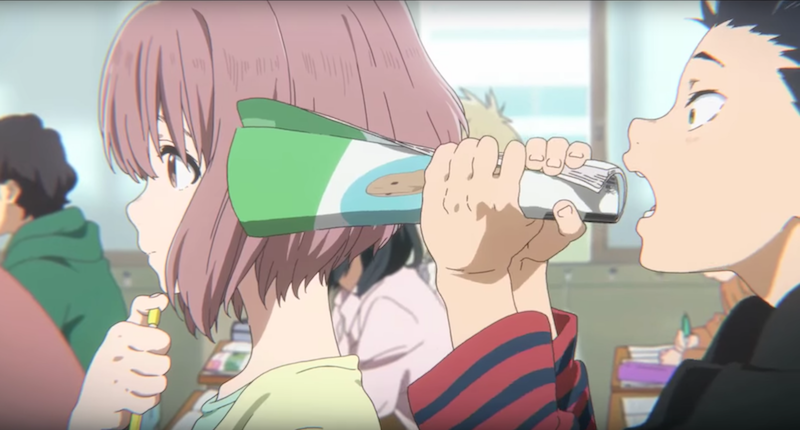Enemies Reunited
May 18, 2017 · 0 comments
By Jonathan Clements.
 Partway through the Glasgow screening of A Silent Voice, its director Naoko Yamada has sunk low in the chair next to me, hugging her bulky coat to her like a blanket. Watching a Japanese film with its director is not necessarily a common experience. Some have wanted to sit in with the Scottish crowd for the sheer novelty of observing a foreign audience’s reactions, but in many cases, by the time a film makes it out of Japan, its makers are thoroughly sick of it. They watched it so many times that now all they can see is the bits they wish they had more time to redo. But Yamada is reliving her own film as if it is the first time she has ever seen it. She sniffs and I realise that she is holding back a sob.
Partway through the Glasgow screening of A Silent Voice, its director Naoko Yamada has sunk low in the chair next to me, hugging her bulky coat to her like a blanket. Watching a Japanese film with its director is not necessarily a common experience. Some have wanted to sit in with the Scottish crowd for the sheer novelty of observing a foreign audience’s reactions, but in many cases, by the time a film makes it out of Japan, its makers are thoroughly sick of it. They watched it so many times that now all they can see is the bits they wish they had more time to redo. But Yamada is reliving her own film as if it is the first time she has ever seen it. She sniffs and I realise that she is holding back a sob.
“Did I actually see you crying in there?” I ask her later.
“No!” she lies.
Japanese drama is thickly populated with osana-najimi (“childhood friends”) reunited as adults. In tales like Fumi Saimon’s Tokyo Love Story (manga 1988, TV 1991), the suggestion of a childhood friendship has been a handy, off-the-shelf backstory, used to swiftly delineate new characters. Among wallflowers and shut-ins, it’s often the only way to establish meaningful contact outside a character’s own family, and most of the time, it’s used as a short-hand for unrequited love. Not all childhood friends are romantic leads; sometimes, they are a past association that needs to be put aside before a leading character can make it in the big city, an old flame that needs to be gently snuffed out, or a jilted ex waiting by the boiler with a bunny.
 Yoshitoki Oima’s manga A Silent Voice took a radical approach to the osana-najimi tradition, setting the first of its seven volumes at elementary school, before leaping ahead to the characters as teenagers. But Shoko and Shoya are far from childhood friends. Instead, she was the deaf girl newly arrived in class, and he was the ringleader of a concerted and heartless carnival of abuses that caused her to switch schools.
Yoshitoki Oima’s manga A Silent Voice took a radical approach to the osana-najimi tradition, setting the first of its seven volumes at elementary school, before leaping ahead to the characters as teenagers. But Shoko and Shoya are far from childhood friends. Instead, she was the deaf girl newly arrived in class, and he was the ringleader of a concerted and heartless carnival of abuses that caused her to switch schools.
Years later, Shoya has fallen from his height as king of the classroom – ostracised by his classmates, he is a friendless loner contemplating suicide. The story finds its drama, at first, in his inept attempts to make amends, before broadening into an investigation of human frailty and redemption. “It is a love story,” notes director Yamada, “but that’s not the most important part of the work. It’s a story about coming of age, and love is only part of that.”
A Silent Voice had a rollercoaster ride to success. Despite winning a Kodansha comics competition in 2008, it sat unpublished for three years as editors and lawyers debated its provocative stance. Disability drama is a recognised sub-genre in the Japanese media, but usually strives for a worthy, didactic message. The implied audience is all too often an ignoramus who needs to be educated about specific conditions. Such stories are often termed Pure dramas, deriving their name from the autism-related 1996 TV series of the same name. But A Silent Voice often focussed not on the saintly deaf girl but on the young thug who bullied her, along with his classmates’ casual disinterest. When it finally saw print in 2011, it did so with a ringing endorsement from the Japanese Federation of the Deaf: “Please publish it as it is and do not change a thing.”
As the original one-shot transformed into an ongoing serial in Weekly Shonen Magazine, critics were divided. Some readers were shocked that the “voices” being heard were not merely those of the marginalised deaf, but of their persecutors, in particular the leading man Shoya, who proves to be an unreliable narrator, even as he attempts to mend his ways. Meanwhile, the deaf Shoko’s status as an innocent ingénue is repeatedly challenged until she starts to look like a willing victim – shouldn’t she cut the world around her some slack, or at least attempt to meet it halfway? “This is a film about Shoya,” agrees Yamada. “It’s told from his point of view, and in a sense, he is a person who has chosen not to hear.”
A Silent Voice is a deliberately challenging work, repeatedly introducing stereotypical characters and situations, only to subvert and transform them with additional information. It deals not only with disability, but spousal abandonment, single parenthood, the integration of immigrants, suicide and most notably of all, bullying. Despite, or perhaps because it seemed to point to bullying as a veritable national pastime more iconic than sumo or origami, its final volumes came garlanded with awards, leading to the periodic best-of list Kono Manga Ga Sugoi crowning it as the best comic in Japan.
For the anime adaptation, Yamada spent many hours in conversation with the original creator Oima. “She showed me a lot about the series that allowed me to create a purer, higher-quality work… She has a very high emotional connection to the original so I had to carefully consider what was worth taking.” Along with her frequent collaborator, writer Reiko Yoshida, she hammered the cliff-hangers and revelations into a narrative that would work across the length of a feature film. “If you use the same pacing in the movie, you end up with nothing but a mundane digest of what happens in the manga.”
Yamada and Yoshida’s compression does away with many subplots and incidental characters, significantly reducing the screen time for many members of what was once a seven-strong ensemble cast, itself a solid, recurring trope in Japanese drama since the landmark TV show Seven People in Summer (1986). Most notably, she ditches a film-making subplot – a wise move, considering that a sign-language theatre production was the core of Japan’s previous deaf-focussed feature hit, I Love You (1999). But she also uses subtle visual cues to reinforce the message of the story itself – the vibrations caused by sound in water, those subtle moments where, just for an instant, even the hearing characters are momentarily deafened by waterfalls and traffic, silenced by noise pollution or in one key moment, struck dumb by hospitalisation.
 “It’s the scenes with Shoya’s mother that affect me the most,” Yamada observes, talking about her own film as if she is just another member of the audience. “They do make me cry. She has worked so hard, put so much into raising her son right, and then he goes and ruins things, repeatedly.” Shoya’s mother is repeatedly depicted with shortcuts that, in Japanese television, would mark her out as a chav – her hairstyle, her profession, her daily concerns. But in her actions, she is unfailingly heroic and pure of heart, putting love before money on every occasion, with deeds that even win over Shoko’s doubting, wounded mother.
“It’s the scenes with Shoya’s mother that affect me the most,” Yamada observes, talking about her own film as if she is just another member of the audience. “They do make me cry. She has worked so hard, put so much into raising her son right, and then he goes and ruins things, repeatedly.” Shoya’s mother is repeatedly depicted with shortcuts that, in Japanese television, would mark her out as a chav – her hairstyle, her profession, her daily concerns. But in her actions, she is unfailingly heroic and pure of heart, putting love before money on every occasion, with deeds that even win over Shoko’s doubting, wounded mother.
Look out for repeated references onscreen to things being not as they seem on the surface. Such a directorial stance from Yamada, which extended even to the depiction of the world itself, with self-involved teenage angst taking place amid intricate scenes of natural beauty, has led some to praise her as one anime’s quieter, yet most intriguing auteurs. Tiny gestures, such as Shoya’s wordless aid in helping his niece get down from her chair, and cutaway shots of flowers that carry certain poetic meanings in Japanese, form subtle character moments that point, once again, to unspoken depths. Miles Thomas, the juror at the 2016 Scotland Loves Anime festival who assigned both his votes to the film, provocatively contrasted Yamada’s work with the picture-book scenery of Makoto Shinkai, noting “…with Yamada, nothing is wasted. I have never seen a director shine so much since Mamoru Oshii.” Even The Who’s ‘My Generation’, which backs the striking, jump-cut opening montage, is a careful, calculated decision. “The sound director wanted something evergeen, something that everyone remembers,” Yamada recalls. “I was doing a location scout in Gifu, and I was walking around, thinking about Shoya’s character. He has this energy and sense of invincibility, but also an underlying boredom. And I thought ‘My Generation’! I went back and announced in a production meeting that I wanted to use it… and the whole room went silent. It took a while to get Pete Townshend’s approval, but the track was cleared internationally.”
However, it’s another song, liable to pass most viewers by, that occurs at three crucial moments in the film, and that’s Fumiko Okada and Osamu Shoji’s ‘The Kaiju Ballad’, a classic from a 1972 TV singalong show that has become something of a Japanese school choir staple. We see Shoko murdering it in music class as a young girl, and then a flash of her and Sahara belting it out in a karaoke room as teenagers. But it’s also the song that a humbled, wounded Shoya stammers through as he faces his crisis of faith in himself: “Wanting to see the sea / And somebody to love me / Even monsters have a heart…”
A Silent Voice adds an additional layer of complexity with its depiction of dialogue in sign language. “Each of the characters in A Silent Voice carries with them completely different emotions,” observes Yamada. “There are points where they don’t speak their real feelings, and there’s points where they say what they mean.” The translation on the English print copes admirably with such issues, deftly deciding when it is best to subtitle sign-language as if it is speech, and when it is best to force the viewer to try to understand unaided. This throws the viewer in with Shoya as he tries to learn how to communicate with the girl he once wronged, but also permits a true understanding of Shoko’s frustrations as she struggles to make herself heard.
Jonathan Clements is the author of Anime: A History. A Silent Voice will be available on several UK digital platforms, starting 22nd May.

Leave a Reply